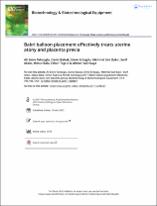| dc.contributor.author | Tahaoğlu, Ali Emre | |
| dc.contributor.author | Balsak, Deniz | |
| dc.contributor.author | Erdoğdu, Emre | |
| dc.contributor.author | Bakır, Mehmet Sait | |
| dc.contributor.author | Akşin, Şerif | |
| dc.contributor.author | Bala, Mesut | |
| dc.contributor.author | Toğrul, Cihan | |
| dc.contributor.author | Yalınkaya, Ahmet | |
| dc.date.accessioned | 2019-05-13T09:03:30Z | |
| dc.date.available | 2019-05-13T09:03:30Z | |
| dc.date.issued | 2017 | |
| dc.identifier.citation | Tahaoglu, A. E., Balsak, D., Erdogdu, E., Bakır, M. S., Aksin, S., Bala, M., Toğrul, C., Yalınkaya, A. (2017). Bakri balloon placement effectively treats uterine atony and placenta previa. Biotechnology & Biotechnological Equipment, 31(4), 795-799. | en_US |
| dc.identifier.issn | 1310-2818 | |
| dc.identifier.uri | https://doi.org/10.1080/13102818.2017.1298467 | |
| dc.identifier.uri | https://hdl.handle.net/11491/1484 | |
| dc.description.abstract | The aim of this study was to explore the success rates of Bakri balloon placement in patients with placenta previa and uterine atony. In addition, we compared bilateral internal iliac artery ligation (B-IIAL) and Bakri balloon placement in terms of their ability to inhibit haemorrhage in postpartum placenta previa patients. The hospital reports filed annually from 2010 to 2015 were reviewed. In total, 54 patients were evaluated: 42 patients with placenta previa and uterine atony were treated with Bakri balloons, and 12 placenta previa patients with postpartum haemorrhage underwent B-IIAL when medical treatment failed. The results showed that the success rates of Bakri balloon placement rate in placenta previa and uterine atony patients were 71.4% and 89.2%, respectively. The comparative analysis of placenta previa patients treated via Bakri balloon placement and B-IIAL showed that the requirements for packed red blood cell and fresh frozen plasma, pre- and post-partum haemoglobin levels, pre- and post-partum platelet counts, and hospitalization times differed significantly between the two groups (all p < 0.05). Bakri balloon tamponade could be considered an effective treatment for placenta previa and uterine atony. The technique is minimally invasive and can serve as a second-line treatment for patients with postpartum haemorrhage when medical procedures fail. © 2017 The Author(s). Published by Informa UK Limited, trading as Taylor & Francis Group. | en_US |
| dc.language.iso | eng | |
| dc.publisher | Taylor and Francis Ltd. | en_US |
| dc.relation.isversionof | 10.1080/13102818.2017.1298467 | en_US |
| dc.rights | info:eu-repo/semantics/openAccess | en_US |
| dc.rights | Attribution 4.0 International (CC BY 4.0) | * |
| dc.rights.uri | https://creativecommons.org/licenses/by/4.0/ | * |
| dc.subject | Bakri Balloon | en_US |
| dc.subject | Placenta Previa | en_US |
| dc.subject | Postpartum Haemorrhage | en_US |
| dc.subject | Uterine Atony | en_US |
| dc.title | Bakri balloon placement effectively treats uterine atony and placenta previa | en_US |
| dc.type | article | en_US |
| dc.relation.journal | Biotechnology and Biotechnological Equipment | en_US |
| dc.department | Hitit Üniversitesi, Tıp Fakültesi, Cerrahi Tıp Bilimleri Bölümü | en_US |
| dc.identifier.volume | 31 | en_US |
| dc.identifier.issue | 4 | en_US |
| dc.identifier.startpage | 795 | en_US |
| dc.identifier.endpage | 799 | en_US |
| dc.relation.publicationcategory | Makale - Uluslararası Hakemli Dergi - Kurum Öğretim Elemanı | en_US |



















